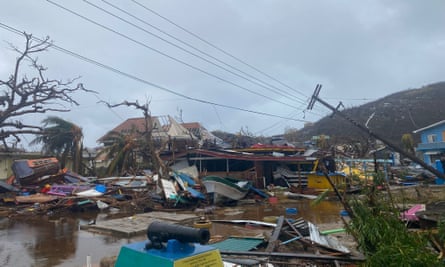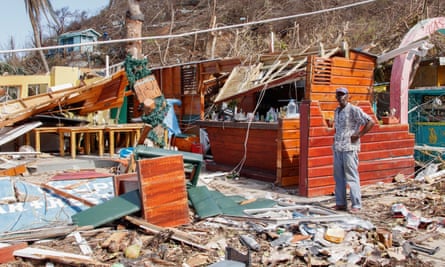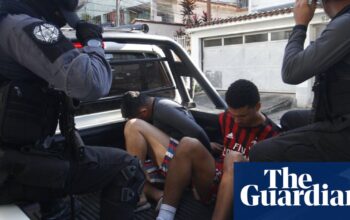On the island of Union in St Vincent and the Grenadines, where the category 4 Hurricane Beryl caused “Armageddon-like” destruction, demolishing more than 90% of the buildings, there is a solitary wooden house standing defiantly among the wreckage.
A picture of the quaint yellow building with a mauve roof, bafflingly out of place among an array of debris and roofless structures, has been shared more than 500 times on Facebook. In a deeply religious country where more than 80% of the population are Christians, it has triggered a debate about whether its survival is a miraculous message from God.
The owner of the house, Joseph Franklyn, 60, who was feared dead after refusing to leave the house for secure shelter before the storm, firmly believes that his home and his life were spared by a “mighty God”.
He said he chose to stay in his home during the hurricane because of his faith in God. The house was built by members of the local Rocky Hill Seventh-day Adventist church to rescue him from the dilapidated hut in which he had previously lived.
Many, including some members of the SDA community, share his conviction. Pastor Kenan Cain, who is connected to the church in Union, said it was amazing that the house survived when similarly built plywood homes and supposedly stronger concrete structures in the area were destroyed.
“We can’t say it was built stronger than the others or the materials used were better because the base of the house is concrete, the bathroom is concrete, but the rest of the house is plywood, so I was surprised that it was standing because in Union I don’t think there isn’t a single plywood house that is standing,” Cain said.
But on social media, some disagreed. “We suffer from a simple-thinking colonial mindset that anything extraordinary must be a supernatural event,” one comment said. “I believe in God. I love the ‘message’ but it’s simply a matter of better/different construction, positioning, craftsmanship etc. It ain’t that deep.”
Another questioned why God had seen “fit to destroy everyone else’s house”.

Whatever the view, Franklyn’s story, which began with a chance meeting with Rocky Hill’s SDA men’s ministry leader, James Saxon, is a remarkable tale of survival in a country where bodies are still being found during clean-up operations days after the hurricane hit on 1 July.
Saxon said he met Franklyn on a boat and was moved to help him after discovering he was living in a dilapidated shed without proper protection from the elements and pests such as cockroaches and mice. “He had had a stroke and was very sick and was living in a place that was basically a shed with a dirt floor and was not eating properly. Because of his situation, I was concerned,” he said.
Saxon invited Franklyn into the Rocky Hill Seventh-day Adventist church community. Later, his wife began caring for Franklyn, and church members donated money, materials and time to build him a new house.
Saxon, who oversaw the construction, described the house as “very nice”, with everything Franklyn needed to live comfortably. But as Hurricane Beryl approached, he and his wife urged Franklyn to evacuate.
“My wife told him he would need to leave because it is a wooden building and it would not be able to withstand the force of the hurricane. But he told her: ‘God give me this, I watched this build, and God will protect it. I am not moving. I am staying right here.’”
Saxon said he and his wife were concerned and frustrated with Franklyn’s refusal to evacuate. And when the storm hit their own home, forcing them to seek refuge, they feared the worst. “I told my wife, Mr Franklyn dead! He dead!,” he said.
But after the hurricane, as Saxon approached the brow of the hill above Franklyn’s house, he saw that the building was still intact and had minimal damage. “I couldn’t believe it! Imagine, my house mash up and Mr Franklyn’s house was still there. And when we got to the house, he was sipping hot tea and eating Crix crackers.”

Franklyn, who was evacuated with other Union Island residents and is now in a shelter in St Vincent, admits he did not expect the storm to be so dangerous, until he saw roofs flying. He explained how he remained safe inside with only a broken window and some water damage while the buildings around him crumbled.
Cain believes that his story and the solitary standing house is a clear message from God. “I believe God allowed that house to stand because he wants us to realise that, amidst the chaos, we can still find peace.”
SVG’s prime minister, Ralph Gonsalves, has continuously praised the resilience of the Vincentian people, who have endured a string of disasters in recent years.
“My country has had four significant disasters or emergencies since 2020. Covid, which we all know. In 2021, in April of that year, there were 21 volcanic eruptions. In July of that year there was Hurricane Elsa and then now a category 4 hurricane.
“In between, interspersed by excessive rainfall causing floods and land degradation. All of these are connected to deleterious climate change, and this matter has to be addressed by humanity,” he said at a joint press conference with Grenada’s prime minister, Dickon Mitchell, on Thursday evening.
The two leaders, whose countries bore the brunt of Beryl’s impact in the Caribbean, joined forces to appeal to the conscience of the “major emitters” that have caused the climate crises linked to more frequent and furious hurricanes.
Describing the utter and complete devastation in some parts of their countries, they said the people of Grenada and SVG needed help now. They estimated that nearly 20,000 people across the two countries were homeless or living in badly damaged houses, and their fishing, agricultural and tourism sectors were severely compromised.
Mitchell said: “In the normal scheme of things, disbursement periods are [in the] best-case scenario four to eight weeks. This is simply too long. In Grenada’s case, in Carriacou and Petite Martinique’s case, in St Vincent and the Grenadines’ case, we need the funds now.”
The money they currently had access to was a “drop in the bucket”, the leaders said, estimating that each country would need to raise hundreds of millions for relief, recovery and rebuilding and to get things back to normal for residents.
Source: theguardian.com


